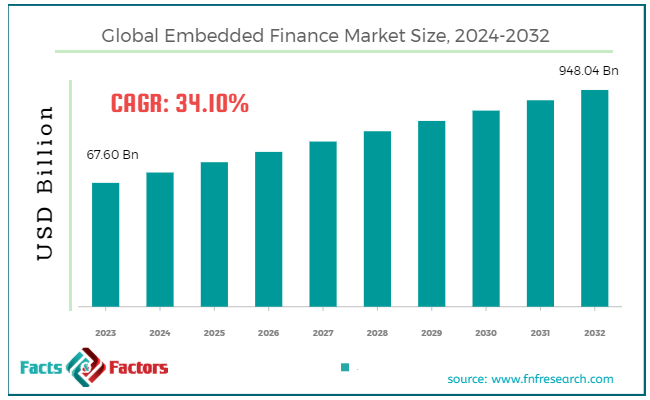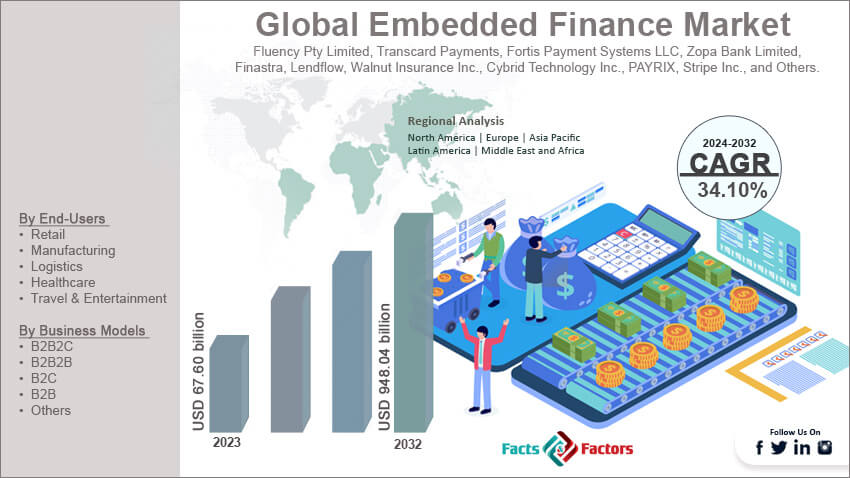Search Market Research Report
Embedded Finance Market Size, Share Global Analysis Report, 2024 – 2032

Embedded Finance Market Size, Share, Growth Analysis Report By End-Users (Retail, Manufacturing, Logistics, Healthcare, Travel & Entertainment, And Others), By Business Models (B2B2C, B2B2B, B2C, B2B, And Others), By Finance Types (Embedded Banking, Embedded Lending, Embedded Investment, Embedded Insurance, Embedded Payment, And Others), And By Region - Global Industry Insights, Overview, Comprehensive Analysis, Trends, Statistical Research, Market Intelligence, Historical Data and Forecast 2024 – 2032
Industry Insights
[214+ Pages Report] According to Facts & Factors, the global embedded finance market size in terms of market volume was valued at USD 67.60 billion in 2023 and is predicted to surpass USD 948.04 billion by the end of 2032. The embedded finance industry is expected to grow by a CAGR of 34.10% between 2024 and 2032.

 Market Overview
Market Overview
Embedded finance refers to the process of integration of financial services with non-financial platforms. It helps businesses to provide services like investment, insurance, payment, and lending on their own platform. These services are built with API's. Different components of embedded finance include investments, banking, insurance, lending, and payments. Customers can easily get these financial services without leaving the platform. Also, it helped companies to increase their customer retention rate and improve customer experience.
 Key Insights
Key Insights
- As per the analysis shared by our research analyst, the global embedded finance market size is estimated to grow annually at a CAGR of around 34.10% over the forecast period (2024-2032).
- In terms of revenue, the global embedded finance market size was valued at around USD 67.60 billion in 2023 and is projected to reach USD 948.04 billion by 2032.
- Rise of e-commerce and digital payments is driving the growth of the global embedded finance market.
- Based on the end-users, the retail segment is growing at a high rate and is projected to dominate the global market.
- Based on business models, the B2B segment is anticipated to grow with the highest CAGR in the global market.
- Based on the finance types, the embedded payment segment is projected to swipe the largest market share.
- Based on region, North America is expected to dominate the global market during the forecast period.

 Growth Drivers
Growth Drivers
- Rise of e-commerce and digital payments is expected to drive the growth of the global market.
The boom of e-commerce is one of the major reasons driving the demand for embedded payment solutions in the market. Embedded finance services help organizations and customers make purchases and manage finance on a single platform.
Also, companies are coming up with more integrated payment gateways, which are further expected to revolutionize the industry. The growing adoption of digital wallets and mobile payment systems like Google Pay is also contributing to the growth of the global embedded finance market. The fast proliferation of digital platforms and services is creating a favorable environment for embedded financial services. However, most non-financial applications adopt APIs to embed financial services on their platforms.
Additionally, consumers are looking forward to a seamless and frictionless experience, which is further widening the scope of embedded financial services. These services help organizations provide financial services on their platforms and eliminate the hassle of switching apps while purchasing or making any transactions.
For instance, Bidmii came up with "Get it Done, Pay Later" in 2023. It is the company's new financial product that is well integrated with Humm's Group financial program. However, Bidmii is widely known for its contribution to the home improvement industry.
 Restraints
Restraints
- Regulatory compliance is expected to hamper the growth of the global market.
There are different complex regulations across the globe governing the finance industry. Such an unfavorable regulatory environment is expected to hinder the seamless integration of financial services across borders. Also, an unclear framework creates uncertainty in businesses. Therefore, it is likely to hamper the growth of the embedded finance industry.
 Opportunities
Opportunities
- Shift to cashless economies is expected to foster growth opportunities in the global market.
The increasing shift towards cashless transactions is a major factor positively impacting the growth of the industry. Consumers and businesses are both moving away from traditional cash-based systems. The surge of fintech start-ups and banking as a service platform is further expected to boost growth opportunities in the global embedded finance market. These innovations are making the integration of financial services on non-financial platforms easy.
Also, these help businesses provide financial products like lending, insurance, and wallets without any requirement for a license from financial institutions. The growing financial inclusion among the unbanked population, particularly in developing markets, is another crucial reason expected to support the growth of the industry. Additionally, the launch of super apps like Paytm, Grab, and WeChat are further boosting the demand for embedded financial services.
For instance, Zopa Bank Limited successfully took over DivideBuy in 2023 to launch buy now, pay later offerings in the market. This product combines fintech innovations and technology to process payments instantly and finish the consumer buying journey.
 Challenges
Challenges
- Dependence on third-party providers is a big challenge in the global market.
Non-financial companies depend on third-party providers to embed financial services into their platforms, which limits the company's control over the services they offer. There are many emerging issues, like downtime, service disruptions, and many others, that negatively impact the growth of the embedded finance industry.
 Segmentation Analysis
Segmentation Analysis
The global embedded finance market can be segmented into end-users, business models, finance types, and regions.
On the basis of end-users, the market can be segmented into retail, manufacturing, logistics, healthcare, travel & entertainment, and others. The retail sector is the fastest-growing segment in the embedded finance industry. The growth of e-commerce is significantly revolutionizing the retail sector, which is a major factor in the high growth rate of the segment.
Emerging payment options like credit card services, buy now pay later, and other embedded payment types are contributing immensely towards the growth of the sector. The emergence of retail as a service platform is further expected to fuel the growth of the segment. These platforms use embedded finance in a business model where brands can embed payments and lending options to generate new revenue streams. Appealing loyalty programs and rewards are also increasing the use of embedded financial services on retail platforms, which results in high customer retention rates and improved sales.
Moreover, retailers are adopting many data analytic solutions to gain insights regarding consumer behavior and preferences in order to offer personalized financial products like insurance plans or consumer loans to encourage shopping. Therefore, these factors are expected to positively impact the growth of the segment.
On the basis of business models, the market can be segmented into B2B2C, B2B2B, B2C, B2B, and others. The B2B segment is expected to dominate the global embedded finance market during the forecast period. Companies all around the globe are largely adopting embedded financial services because of the growing demand for integrated financial services. B2B platforms are investing heavily in embedded financial solutions like invoice financing or BNPL to maintain higher cash flow by offering flexible financing options to customers.
Additionally, B2B companies are also emphasizing improving customer experiences by offering frictionless transactions with automated payments and opportunities. B2B transactions are in quite large volumes, and therefore, businesses are adopting embedded finance solutions to boost scalability and cost efficiency. The growing adoption of the embedded finance ecosystem is making it easier for B2B businesses to integrate financial services in their payment models, which in turn is also expected to boost the growth of the segment.
On the basis of finance types, the market can be segmented into embedded banking, embedded lending, embedded investment, embedded insurance, embedded payment, and others. The embedded payment segment will account for the largest share of the embedded finance industry during the forecast period. Embedded payments help organizations facilitate smooth transactions on their platform by retaining customers. Also, faster payments help reduce customer churn rates.
E-commerce and other on-demand services are further fostering the wide-scale adoption of embedded payment solutions. Also, the growing use of mobile payments through mobile wallets, Google Pay, Samsung Pay, Apple Pay, and many others is further positively influencing the growth of the segment.
Additionally, it is fueling the integration of embedded payments into mobile apps, particularly in sectors like food delivery, transportation, and retail. The introduction of buy now, pay later services is also a crucial factor driving the growth of embedded payments in the marketplace. Many retail and e-commerce platforms use the embedded BNPL services directly on their checkout page.
 Report Scope
Report Scope
Report Attribute |
Details |
Market Size in 2023 |
USD 67.60 Billion |
Projected Market Size in 2032 |
USD 948.04 Billion |
CAGR Growth Rate |
34.10% CAGR |
Base Year |
2023 |
Forecast Years |
2024-2032 |
Key Market Players |
Fluency Pty Limited, Transcard Payments, Fortis Payment Systems LLC, Zopa Bank Limited, Finastra, Lendflow, Walnut Insurance Inc., Cybrid Technology Inc., PAYRIX, Stripe Inc., and Others. |
Key Segment |
By End-Users, By Business Models, By Finance Types, and By Region |
Major Regions Covered |
North America, Europe, Asia Pacific, Latin America, and the Middle East &, Africa |
Purchase Options |
Request customized purchase options to meet your research needs. Explore purchase options |
 Regional Analysis
Regional Analysis
- North America to dominate the global market.
North America will account for the largest share of the global embedded finance market during the forecast period. The high adoption rate of digital platforms like fintech firms, e-commerce, and others are the primary reasons for the growing scope of embedded financial services in the region. Businesses in the region are increasingly integrating financial solutions like payments and lending into their platform to enhance customer experience.
The US is the largest market in the region because of the growing presence of fintech and e-commerce companies in the region. Canada is also an emerging market in the region because of the rapid digital transformation and wide-scale use of open banking facilities. Companies in the region are using super apps to embed financial services on the platforms.
Asia Pacific is another major region likely to witness significant growth in the embedded finance industry in the coming years. Increasing access of people to the internet and financial services is the major reason for the high growth rate of the regional market. APAC is known to be the hub of the largest super apps like Grab, Paytm, and WeChat, which is further expected to support the growth of the regional market. These super apps are a one-stop solution for both businesses and consumers.
The region also witnesses many fintech innovations that help non-financial companies to embed financial services into their platforms. China is leading the market in APAC because companies are heavily investing in embedded payment, insurance, and investment services. Also, the rising scope of fintech in India is significantly leading to the development of apps like Razorpay, PhonePe, and Paytm, which in turn is further expected to revolutionize the market.
Therefore, all these factors are likely to contribute significantly towards the growth of the regional market. For instance, Stripe Inc. said it would enter a partnership with Weave in 2023 to process payments on Stripe Connect for Weave's customers in the US. Weave is a one-stop platform for customer engagement and communication.
 Competitive Analysis
Competitive Analysis
The key players in the global embedded finance market include:
- Fluency Pty Limited
- Transcard Payments
- Fortis Payment Systems LLC
- Zopa Bank Limited
- Finastra
- Lendflow
- Walnut Insurance Inc.
- Cybrid Technology Inc.
- PAYRIX
- Stripe Inc.
For instance, Transcend Payment is said to have partnered with Skyscend Inc. in 2023 to manage and disburse payments from the depository account. Skyscend Pay is a cloud-native platform for invoice automation, and Transcard Payment company deals with embedded payment solutions.
The global embedded finance market is segmented as follows:
 By End-Users Segment Analysis
By End-Users Segment Analysis
- Retail
- Manufacturing
- Logistics
- Healthcare
- Travel & Entertainment
- Others
 By Business Models Segment Analysis
By Business Models Segment Analysis
- B2B2C
- B2B2B
- B2C
- B2B
- Others
 By Finance Types Segment Analysis
By Finance Types Segment Analysis
- Embedded Banking
- Embedded Lending
- Embedded Investment
- Embedded Insurance
- Embedded Payment
- Others
 By Regional Segment Analysis
By Regional Segment Analysis
- North America
- The U.S.
- Canada
- Mexico
- Europe
- France
- The UK
- Spain
- Germany
- Italy
- Rest of Europe
- Asia Pacific
- China
- Japan
- India
- Australia
- Southeast Asia
- Rest of Asia Pacific
- The Middle East & Africa
- Saudi Arabia
- UAE
- Egypt
- Kuwait
- South Africa
- Rest of the Middle East & Africa
- Latin America
- Brazil
- Argentina
- Rest of Latin America
Industry Major Market Players
- Fluency Pty Limited
- Transcard Payments
- Fortis Payment Systems LLC
- Zopa Bank Limited
- Finastra
- Lendflow
- Walnut Insurance Inc.
- Cybrid Technology Inc.
- PAYRIX
- Stripe Inc.
Frequently Asked Questions

Copyright © 2024 - 2025, All Rights Reserved, Facts and Factors


